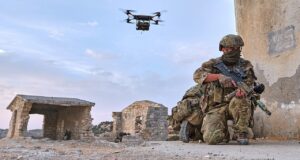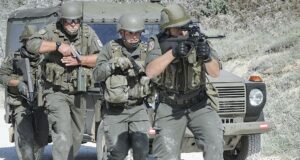by Simon Schofield – Senior Fellow
2nd October 2013. Security and Defence, Issue 4, No. 1.
Whilst al-Qaeda has never been a particularly centralised organisation, in recent years it appears to have shifted from a model of a centralised franchise, which supports other groups to carry out attacks in their name, to a fractured structure of regional groups, each with its own internal politics and personal missions. This is not an al-Qaeda in decline, but an al-Qaeda in transition.
With conventional, traditional counterterrorism, the mantra was that you cut off the head of the snake and the body would die with it. But what if the snake is not a snake? What if al-Qaeda’s structure is more like a Hydra?
In a characteristically brash way, Leon Panetta commented shortly after taking office as Secretary of Defense that al-Qaeda’s strategic defeat was ‘in reach’. He said it was only necessary to kill or capture twenty or so members of the leadership of core groups and affiliates in Pakistan, Yemen, Somalia and North Africa. Whilst doing this would certainly do significant damage to al Qaeda, it was premature and unwise to suggest that ‘defeat’ was imminent.
In Greek mythology, the hero Hercules was tasked with killing the mighty hydra, a sea monster with multiple heads. The problem Hercules faced was that for every head he cut off the hydra, two more grew back in its stead, a problem which is not unlike the problem that counterterrorism faces today with al-Qaeda: it is not a snake. This was made abundantly clear, if it was not already so, with the death of Osama Bin Laden, which failed to finish off al-Qaeda, as some had hoped. Whilst al-Qaeda has never been a particularly centralised organisation, in recent years it appears to have shifted from a model of a centralised franchise, which supports other groups to carry out attacks in their name, to a fractured structure of regional groups, each with its own internal politics and personal missions. Many of these groups now have the support that the central leadership would once have given, including ideological/spiritual support, technical knowledge and money in-house.
Since Bin Laden’s deputy Ayman al-Zawahiri took the helm of al-Qaeda’s overarching structure, al Qaeda has splintered. That is not to say that they have been destroyed, but rather that many of their activities are carried out by the regional fronts. There are likely a number of reasons for this change.
First of all, there is the age-old primary motivator that drives most decisions and actions to one extent or another: necessity. With al-Qaeda’s central leadership, mostly based in the Waziristan region of Pakistan, being hammered on such a regular basis by American drones, they have been unable to plan, support or carry out many attacks because they are on the run – or dead. This will obviously lead either to a specific delegation of responsibility from the central leadership, or the regional leaders taking the initiative and proactively filling the void left by the others.
Secondly, the new arrangement is entirely in line with the current direction of most business models. I well remember at the annual Hull Business Dinner earlier this year a senior businessman from the area explaining that businesses were looking at simplifying their logistical structures in light of the Fukushima earthquake. The earthquake did serious damage to Toshiba and Sony, amongst others, who were operating a model of centralised production, with finished products being shipped abroad. To cut a long story short, the businessman concluded his anecdote by saying that the way of the future for businesses was operating using a ‘local production for local supply’ model. This allows companies to be more responsive to local changes and can help prevent disasters in one place from impacting business operations globally.
Al Qaeda clearly appears to be adopting this strategy. They are still a global group, with members worldwide, capable of attacking a veritable smorgasbord of targets internationally, but their delivery is becoming more localised. In doing so, al-Qaeda avoids the strategic problems it faced merging regional groups directly into the central command.
One of the key issues the old structure faced was that foreign militants migrating into theatres of battle tend to be much more extreme than those born and bred in the local area. This was shown by Abu Musab al-Zarqawi, the monstrous leader of al Qaeda in Iraq (now known as the Islamic State of Iraq and Syria or ISIS), who was killed in 2006. Zarqawi was responsible for many of the brutal beheadings of various innocent people which were broadcast to the world from Iraq during the conflict. He was also responsible for the horrendous campaign of sectarian bombings directed at Iraq’s Shia community. As al-Qaeda’s central leadership recognised, Zarqawi’s ruthless rampages were alienating large sections of Iraqi society who may otherwise have been sympathetic. Keeping regional groups separate from the central command allows regional leadership to exercise stronger control over strategy and membership, to ensure that extremist zealots do not harm their public appeal and recruitment.
There are now many brigades of al-Qaeda which are active within the MENA region. To name but a few active groups there are al-Qaeda in the Islamic Maghreb (AQIM); al-Qaeda in the Arabian Peninsula (AQAP); ISIS (also known as al-Qaeda in Iraq and al-Qaeda in the Land of Two Rivers); Syrian militant group the al-Nusra Front; al-Shabaab in Somalia; Boko Haram in Nigeria and, potentially resurgent in Erbil, the al-Qaeda Kurdish Battalions (currently unconfirmed).
As well as decentralising further, al-Qaeda also appears to be shifting its geographic focus more into Africa, where it hopes to expand its influence. Al Qaeda-affiliated groups have recently been responsible for the siege at the gas plant in Algeria, several massacres in Nigeria, the Kenyan Westgate Mall attack and a threatening video which reveals AQIM’s intentions of operating in Morocco.
This is not an al-Qaeda in decline, but an al-Qaeda in transition.
Simon Schofield is contactable at:
Simon.Schofield@hscentre.org
Please cite this article as:
Schofield, S. (2013). ‘Heads of the Hydra – al Qaeda’s New Direction’
Human Security Centre, Defence and Security, Issue 4, No. 1.
 Human Security Centre Human Rights and International Security Research
Human Security Centre Human Rights and International Security Research




